Having reached the end of the Siq in Petra, I saw al-Khazneh or the Treasury. I believe that this is one of the best known sights in the world as far as archaeological sites are concerned. Although the remains of Petra, the capital of the Nabataean Kingdom (from around 3rd century BCE to 106 CE), are indisputably absolutely impressive, I think that the main thing that kicked off such gross popularity of the site among general public was its role in the world mega-hit film “Indiana Jones and the Last Crusade.”
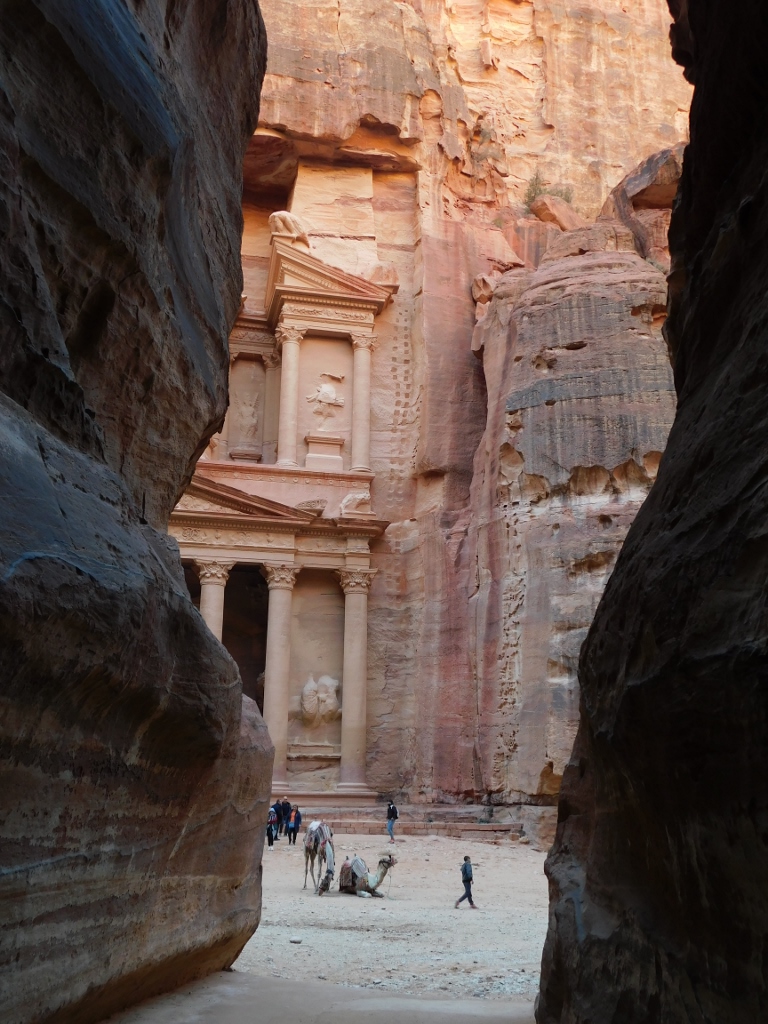 Petra, glimpses of al-Khazneh
Petra, glimpses of al-Khazneh
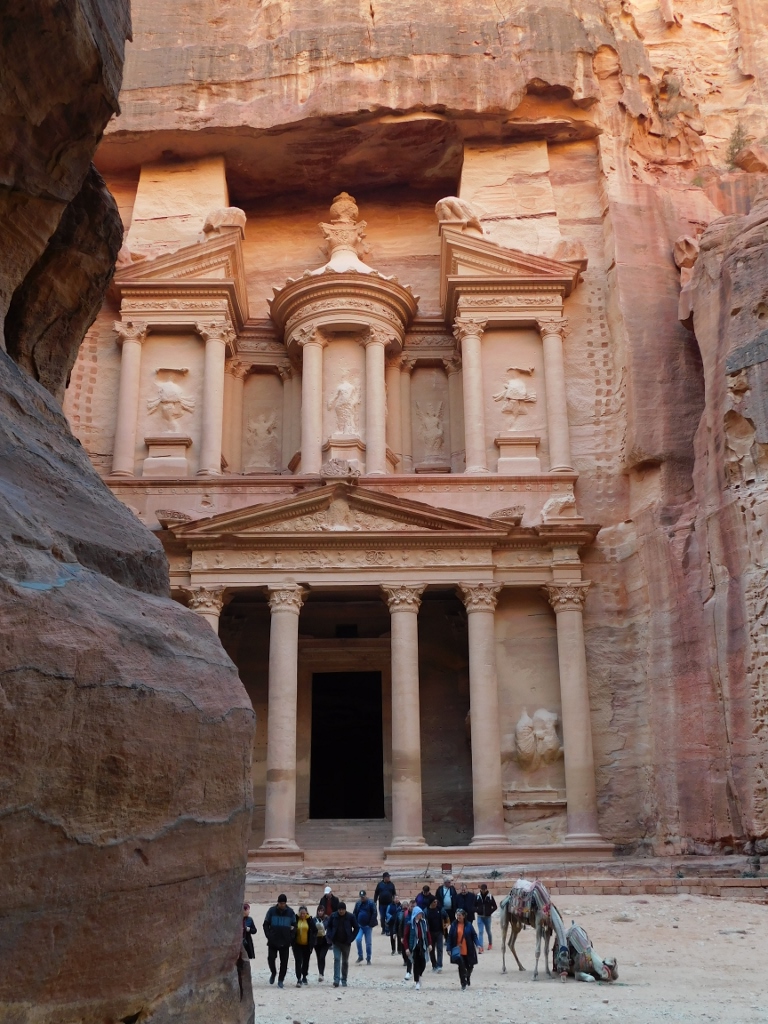 Petra, getting close to al-Khazneh
Petra, getting close to al-Khazneh
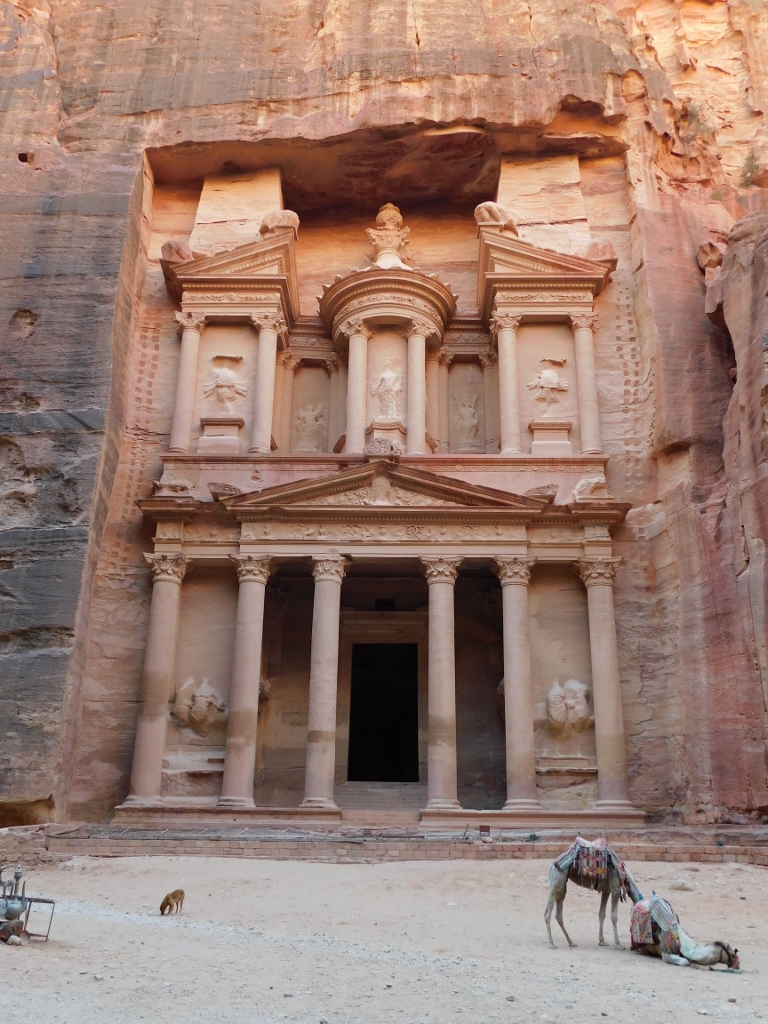 Petra, al-Khazneh
Petra, al-Khazneh
Let me say that apart from the facade, none of the other features of the structure shown in the film are accurate. But, I think that the facade alone is more than enough for one to admire the whole thing. The structure was positioned in such a way that this is what you come across directly when coming to Petra using the main access road.
The Bedouins called this structure “Khazneh al-Fira’un” which means “Pharaoh's Treasury,” but the names used most often are shorter: al-Khazneh or the Treasury. The reason for this name comes from the beliefs of the local population that once upon a time an Egyptian pharaoh fled and here, more concretely in the urn on the top of the facade, hid enormous treasure.
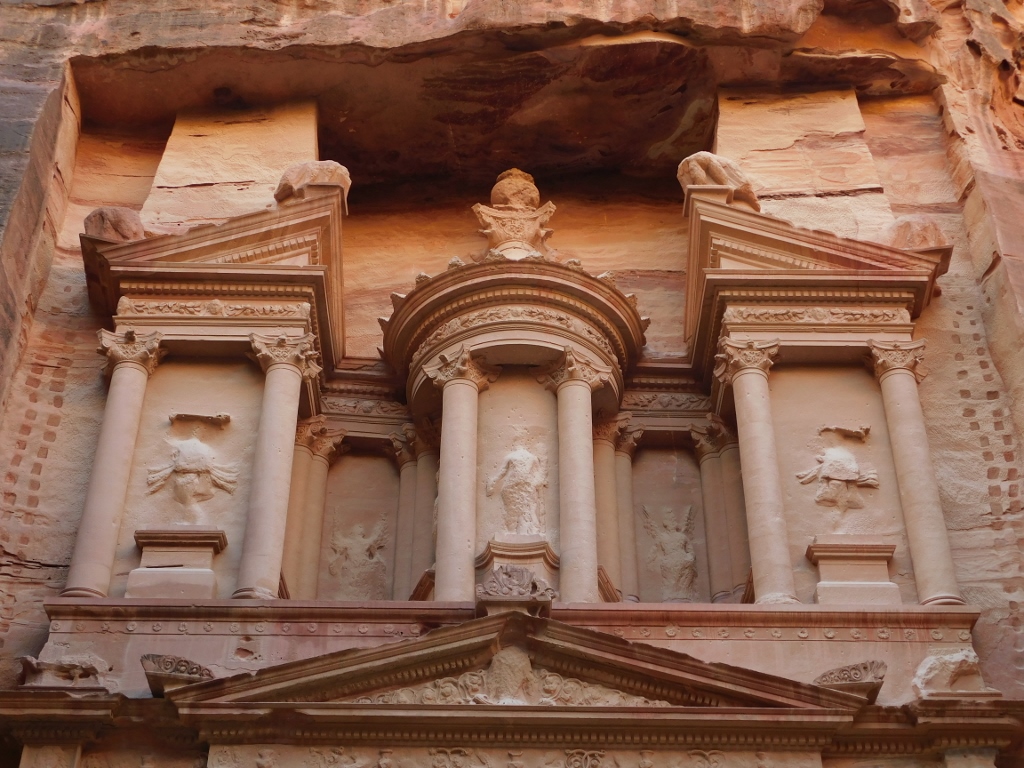 Petra, al-Khazneh, details
Petra, al-Khazneh, details
The urn that is around 3.5 m high can be seen on the top of the central element, the tholos, in the upper section of the facade and when you look at it well you can notice certain damages. These damages on the stone urn were made by the shots of Bedouins who hoped they could destroy it in that way, thus letting the pharaoh’s treasure mentioned in their legend pour down freely.
On the other hand, what is particularly fascinating about the Treasury is the state of its preservation. It is positioned in such a way that it is actually not exposed to the wind and water (rain) erosion, and that is why most of the decoration on the facade have survived in an excellent shape to the present times.
The facade is around 25 m wide and around 40 m high, and it is fully hewn out in a vertical cliff. As for the time when it was made, different sources provide different data. I found somewhere that the Treasury was made in the 1st century BCE, while some other sources mention the 3rd or the 4th century CE. In any case, al-Khazneh is around 2000 years old.
The facade is divided into two zones. In the middle of the upper zone there is a tholos, topped by the urn with the alleged pharaoh’s treasure, while on its front side, between the pillars with richly decorated Corinthian capitals, there is a relief of the ancient Egyptian goddess Isis. Better said – there used to be. Now, only the remains may be seen. Bearing in mind the good state of preservation, for instance, of the capitals on the pillars, it is completely obvious that the human and animal figures were destroyed by the human hand and not by wind or rain. This clearly indicates that iconoclasts, whom I have already mentioned earlier in my travelogue about Jordan, were active here, too. To the left and right from the tholos, in the niches, it is possible to see remains of the winged goddesses of victory, i.e., Nikes, who in ancient tombs symbolise the divine support.
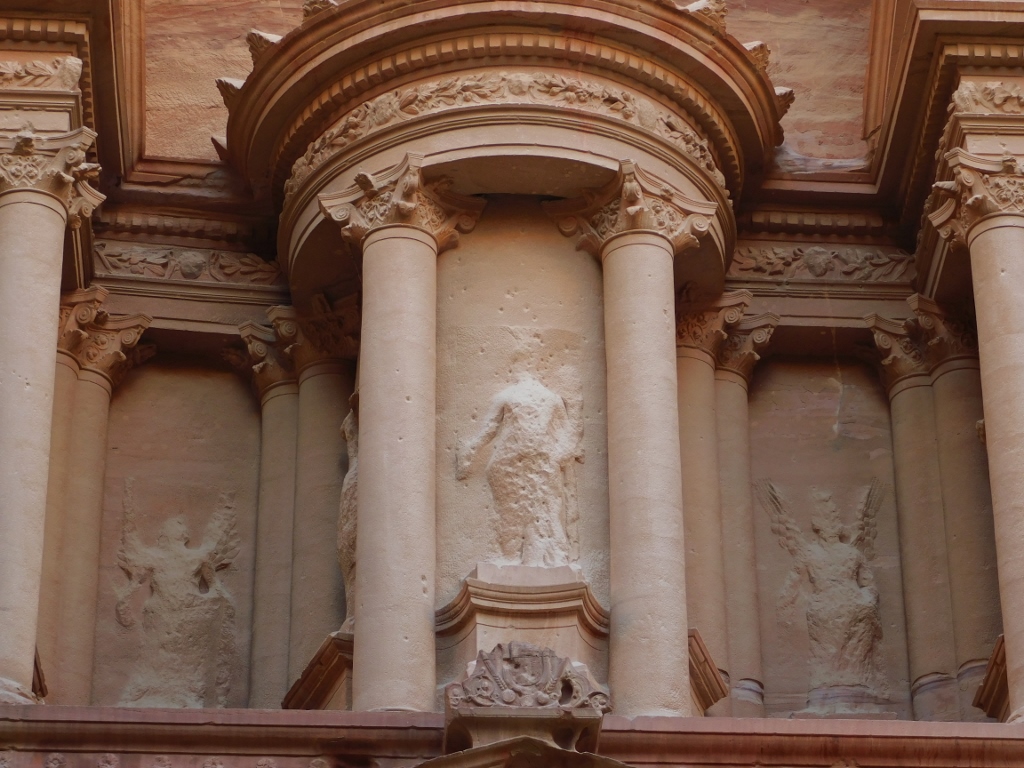 Petra, al-Khazneh, details
Petra, al-Khazneh, details
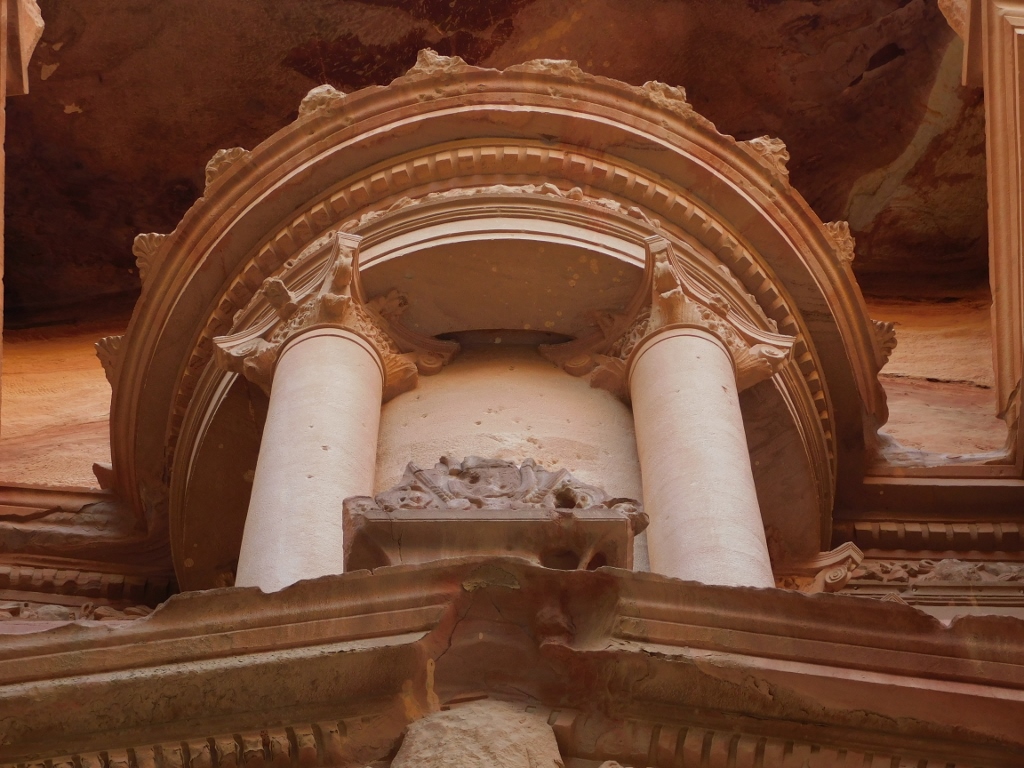 Petra, al-Khazneh, details
Petra, al-Khazneh, details
Further to the right and left from the tholos there are broken pediments on the tops of which there are eagles, i.e., their remains (again this is the “work” of the iconoclasts). According to the Hellenistic tradition that had a major impact on Petra, eagles symbolises Zeus. However, eagles also symbolise god Dushara who was the supreme god within the Nabataean pantheon.
Between the frontal pillars on those broken pediments, as well as on the lateral sides towards the niches with the winged goddesses, it is possible to see remains of the Amazons who most likely used to hold a battle axe in their hands and who in Greek and Roman tombs and sarcophagi symbolise human fight against death.
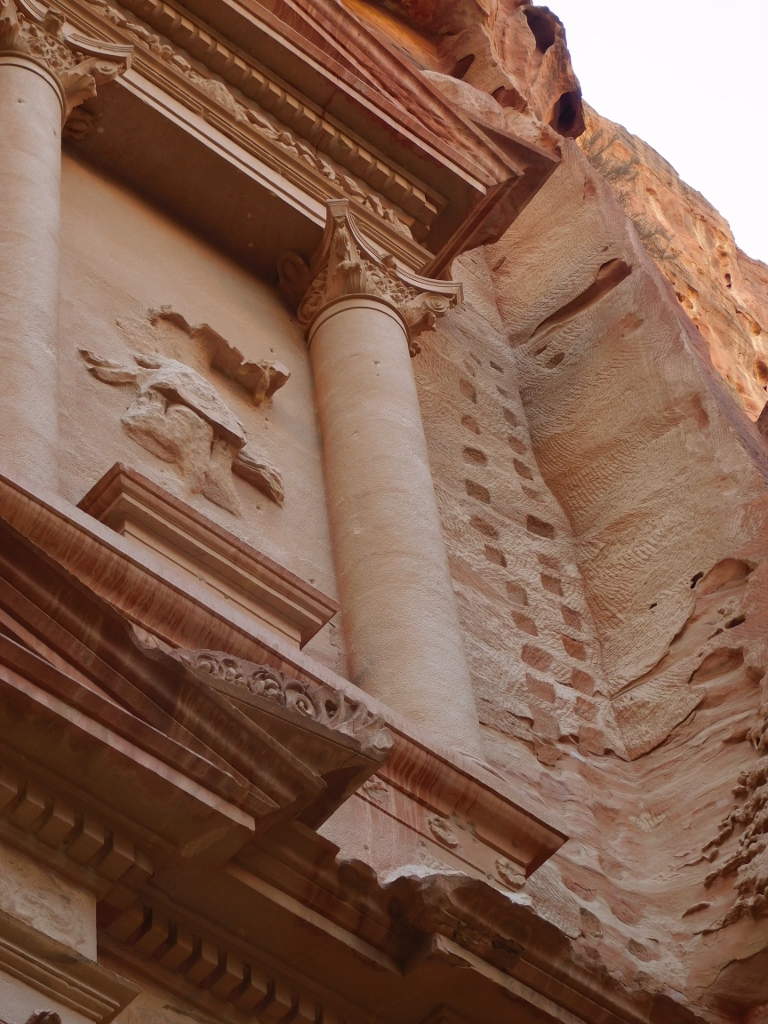 Petra, al-Khazneh, details
Petra, al-Khazneh, details
Right here it needs to be emphasised that in the case of the Treasury the pronounced influence of the Hellenism may be seen not only in the selection of the deities, but also as regards the overall architectural and stylistic elements, since the entire Nabataean culture constituted a mixture of Hellenistic and Near East influences after all.
It also needs to be said that the function of al-Khazneh is not in fact completely clear, but it is presumed that it used to serve as a tomb temple. It is possible that it was the mausoleum of Nabataean King Aretas IV (9 BCE – 40 CE).
In the previous photo, just like in some other ones, it is possible to see vertical sequences of square fields that were hewn to the side from the external pillars of the broken pediments. These were used as the points for resting scaffolding required by craftsmen in order to approach the cliff in which they carved this deep facade.
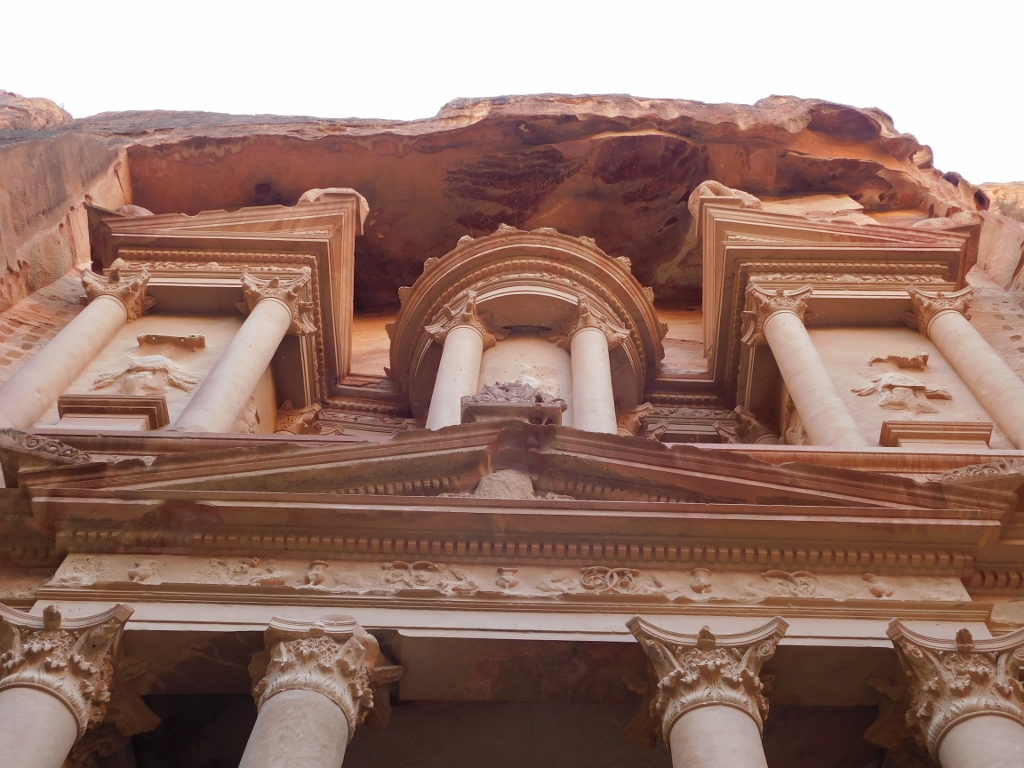 Petra, al-Khazneh, details
Petra, al-Khazneh, details
On the top of the lower section of al-Khazneh’s facade, there is a more or less classic Greco-Roman combination of architectural elements, including an architrave, a frieze and a pediment. All of this is richly decorated, but because of the iconoclasts, only floral motifs have survived.
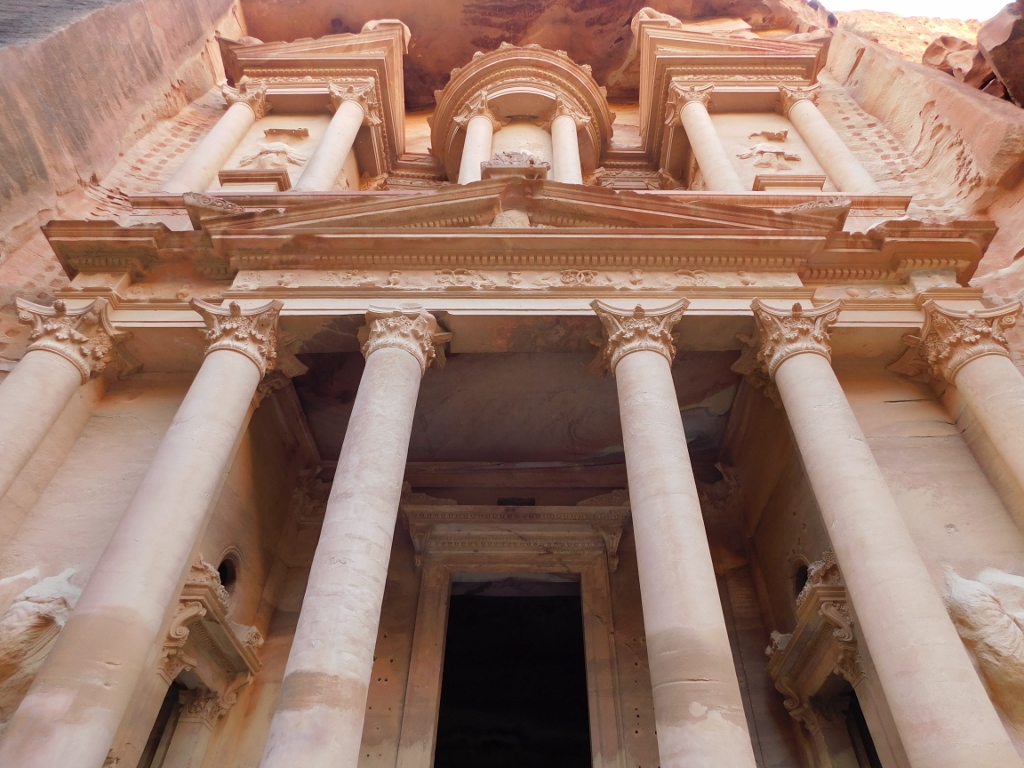 Petra, al-Khazneh, details
Petra, al-Khazneh, details
The architrave is placed over six pillars, the two middle ones of which are free standing. It also needs to be said that the opulently decorated capitals on the pillars from the lower zone are larger than the capitals on the pillars from the upper zone.
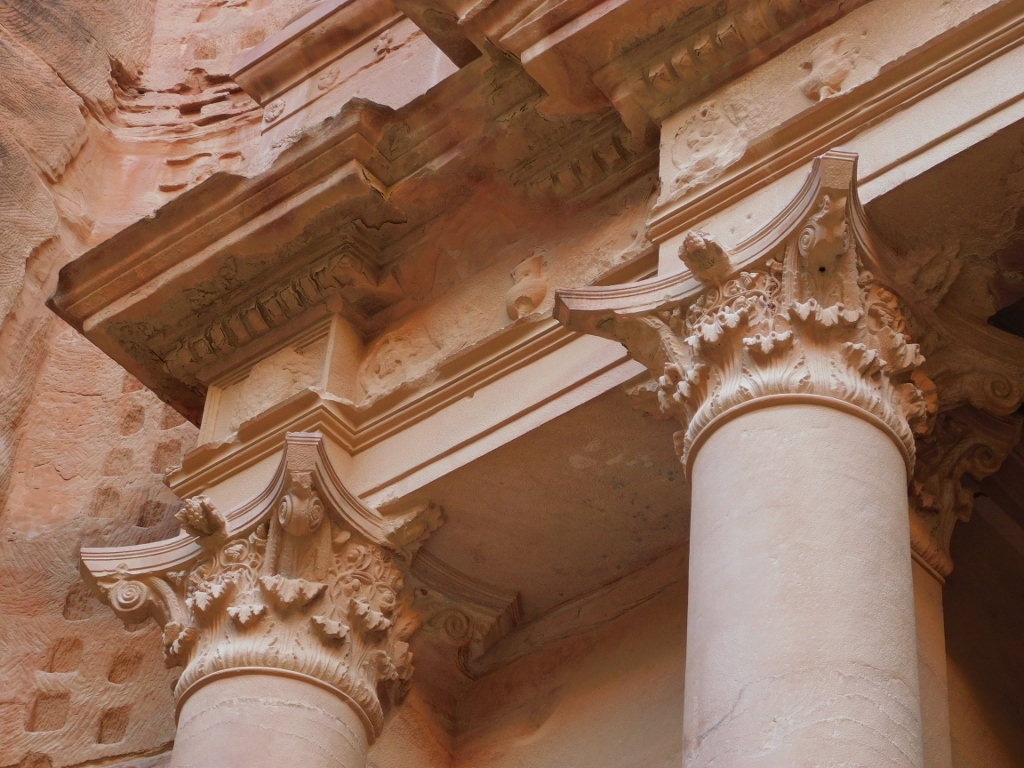 Petra, al-Khazneh, details
Petra, al-Khazneh, details
Out of the six pillars in the lower zone of the Treasury, the left free sanding pillar toppled already during the Antiquity and what can be seen here today is a reconstructed one. However, this is not the most interesting part of this story. What is particularly impressive is that nothing happened to the temple just because one of its pillars collapsed. If a load-carrying pillar/column of a structure toppled, it is certain that the entire structure would also collapse, if not right away, definitely over time. But, not here. The reason is very simple – these are decorative pillars and not load-bearing columns, since the whole structure was carved deep into the cliff.
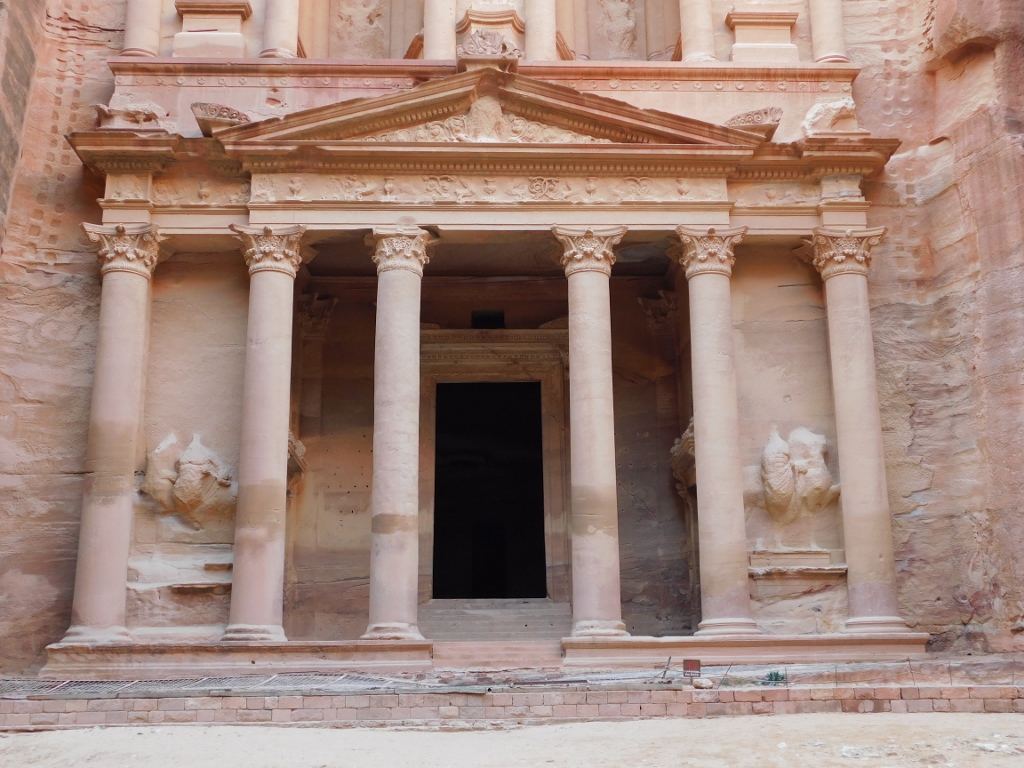 Petra, al-Khazneh: the restored pillar is third from the left
Petra, al-Khazneh: the restored pillar is third from the left
In the photo above, between the exterior pillars on both sides, it is possible to see remains of reliefs showing men standing beside horses. These reliefs are 5 m high and they show the Dioscuri, meaning “god’s sons” and signifying Castor and Polydeuces (ancient Greek version) or Pollux (Roman version). These are twins, Zeus’s sons, and their use here on the tomb is linked to a rather complex explanation, but it can also be said that their role is to be the companions of souls to the afterlife.
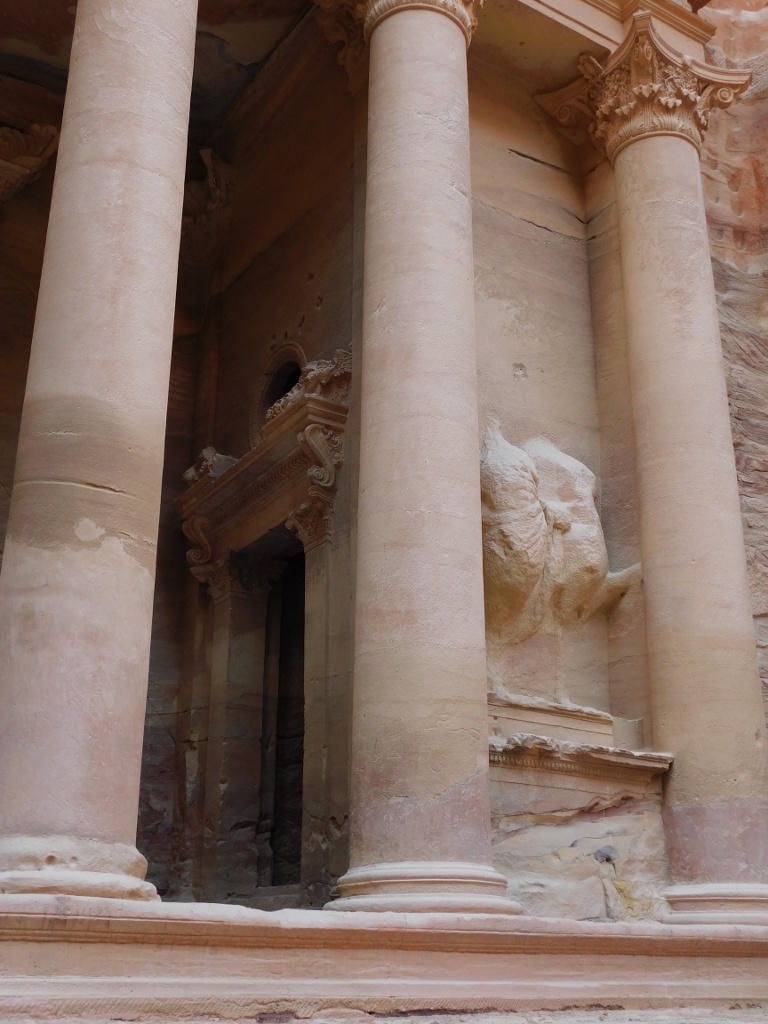 Petra, al-Khazneh: remains of one of the Dioscuri
Petra, al-Khazneh: remains of one of the Dioscuri
Entrance into the Treasury is not permitted, but one can peep a little.
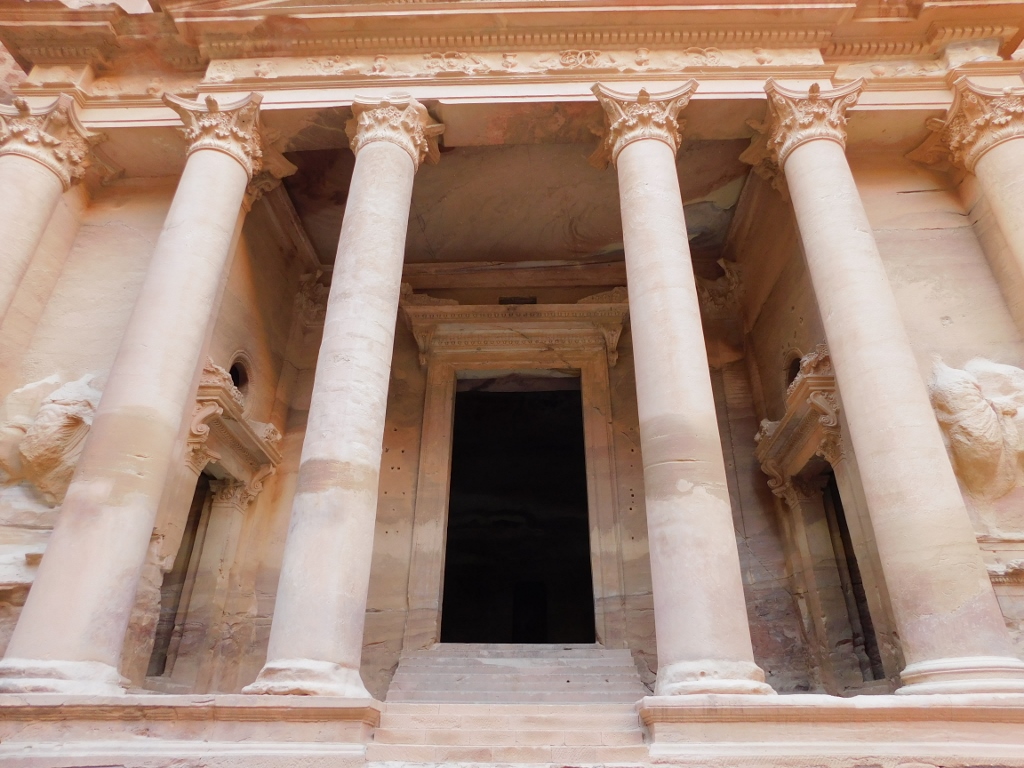 Petra, al-Khazneh, a detail
Petra, al-Khazneh, a detail
If it were permitted to enter here, one would first have to climb four steps leading to the vestibule (14 m wide and 6 m deep) and then up another seven steps to the main doorway. The elegant and massive doorway is also nicely decorated.
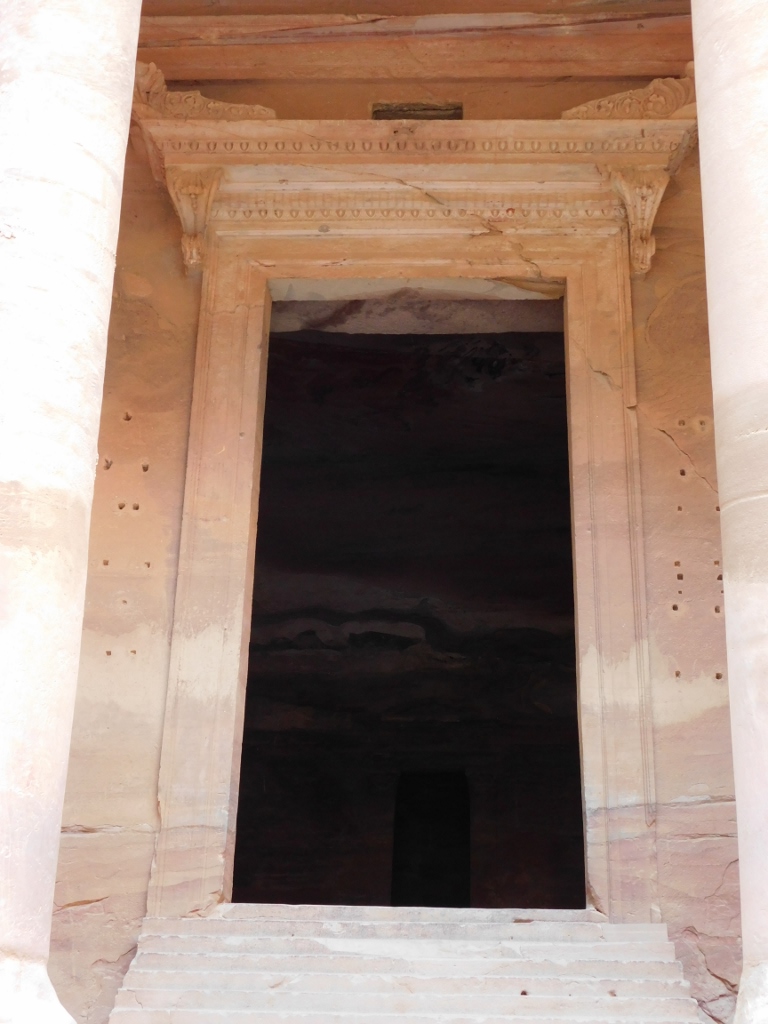 Petra, al-Khazneh, main doorway
Petra, al-Khazneh, main doorway
So, if one were to go through the central doorway, one would enter a cubical chamber (almost a perfect cube). In the back, using a couple of steps, one would go into a small room, while on both flanks there are narrow cuts around 4 m long. The archaeologists have found no traces of graves or some chambers where the mortal remains of the deceased could be laid down.
But, a round, shallow hole has been found in the threshold, as well as a channel leading from it and a small pool at the end of the channel, which is the reason why it is believed that this was the place where animal sacrifice used to be made and these elements served to drain the blood of the sacrificed animals away.
At the ends of the vestibule there are lateral, richly decorated doorways with interesting circular openings above the doorways themselves. This was where the flanking chambers were entered and these are, just like the middle one, also empty.
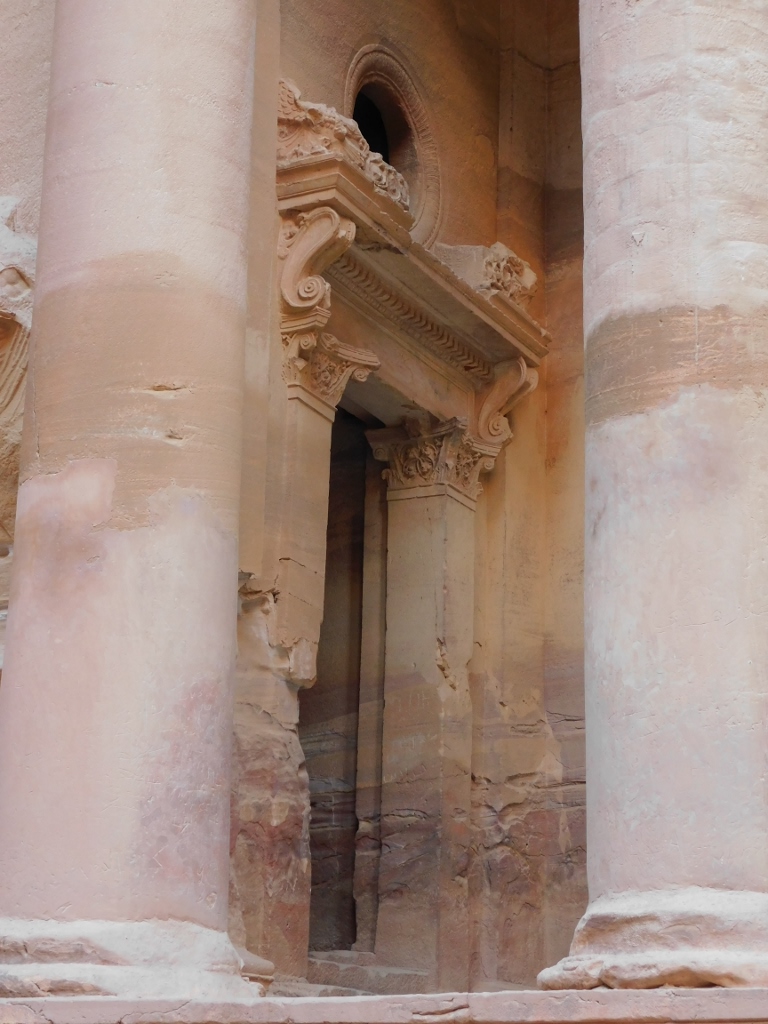 Petra, al-Khazneh, left side doorway
Petra, al-Khazneh, left side doorway
It is interesting that the courtyard in front of the Treasury used to look quite differently at the time of the Nabataeans in comparison to today. To start with, it was some 5 m deeper, it was paved and there was some kind of a pond. From that level, a wide staircase led to older tombs that are situated below al-Khazneh. However, when the Nabataean Kingdom ceased to exist, the structures, including the dams, were not maintained and so the contemporary researchers have established that at least 15 major flash floods covered this courtyard bringing along rubble and damaging it.
When the war in Iraq started in 2003, the number of visitors declined dramatically and so the archaeologists took advantage of such a situation and started to excavate. Today, it is possible to see partially excavated old tombs the oldest one of which was most likely made (also carved out of the rock) around the middle of the 1st century BCE. The Treasury was made a few decades later, above these tombs, and thus their upper sections were “cut off,” but the tombs continued to be used. This may be understood much better when more of such tombs are seen later, walking towards the centre of Petra. Namely, when looking from outside, there is an entrance and a significantly higher facade above it, chiselled in the rock. It was precisely such facade segments that were taken away, but the entrances into the tombs and the tombs themselves remained beneath the Treasury.
I find it completely fascinating when trying to imagine how in the past from the direction of the Siq one could see the entrances into these older tombs, while al-Khazneh almost “floated” above them in all its magnificence and impressive size.
Today, it is possible to see these partially excavated older tombs, but they are protected and one can only look through a horizontal metal grill that goes over their top.
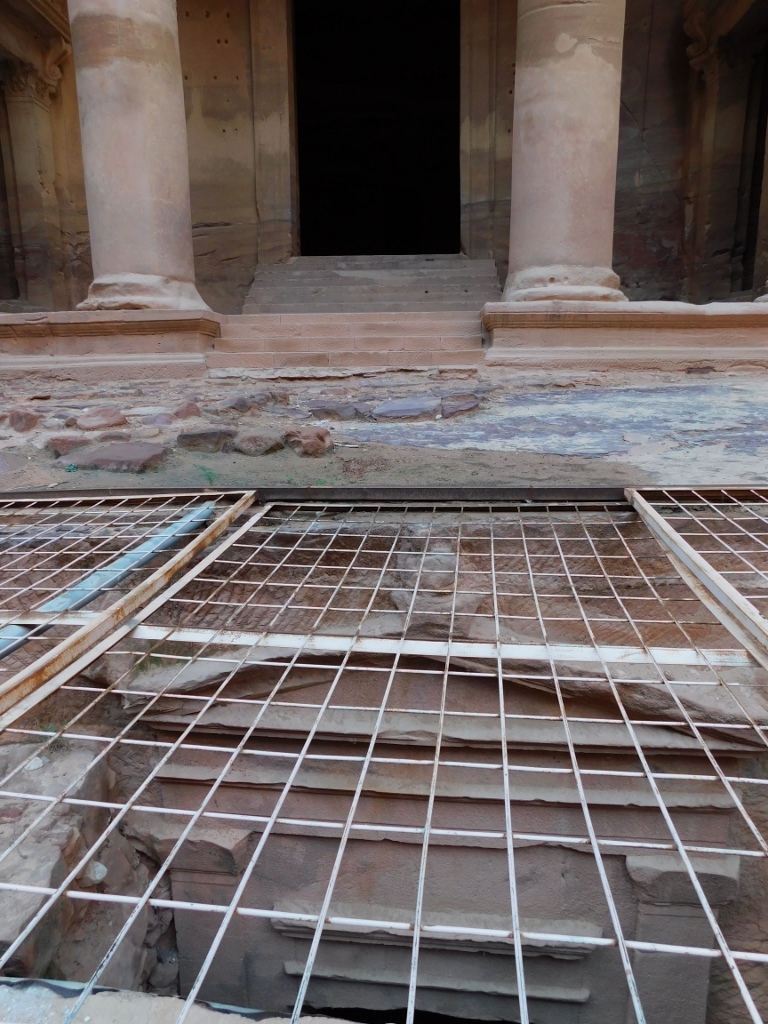 Petra, al-Khazneh, view at the older tombs
Petra, al-Khazneh, view at the older tombs
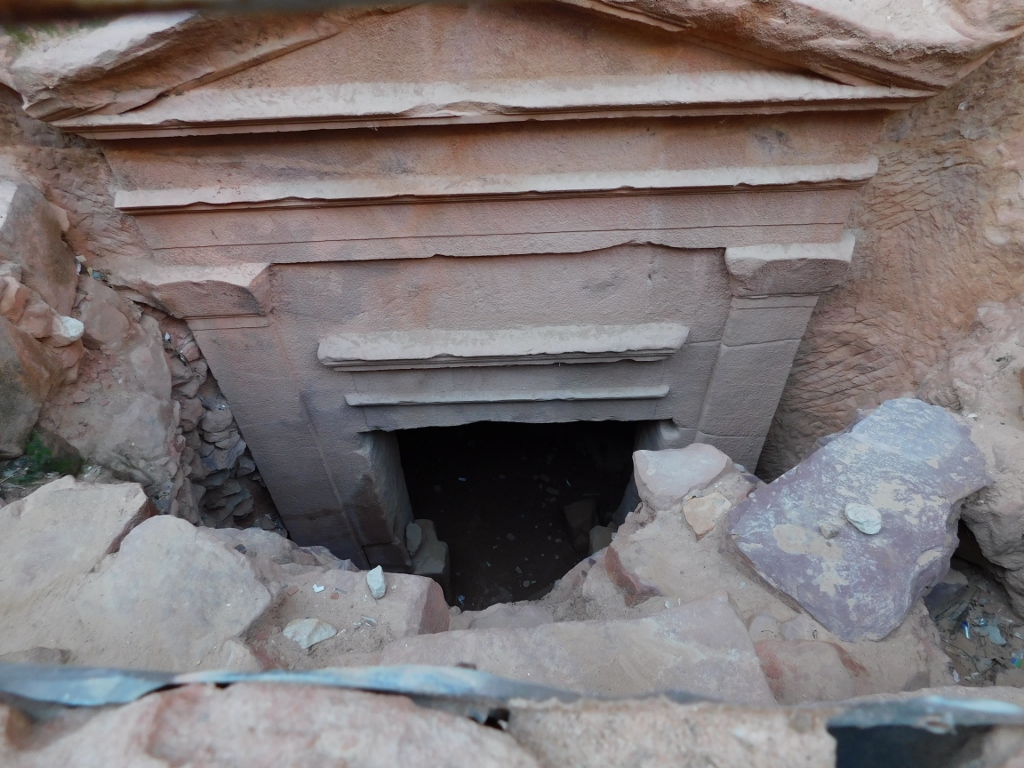 Petra, al-Khazneh, remains of an older tomb
Petra, al-Khazneh, remains of an older tomb
After this detailed dealing with al-Khazneh I was ready to continue with my sightseeing of Petra by walking towards its centre. First, however, I looked a little bit more around the “courtyard” in front of the Treasury that is in fact called valley – the Urn Valley or Wadi al-Jarra.
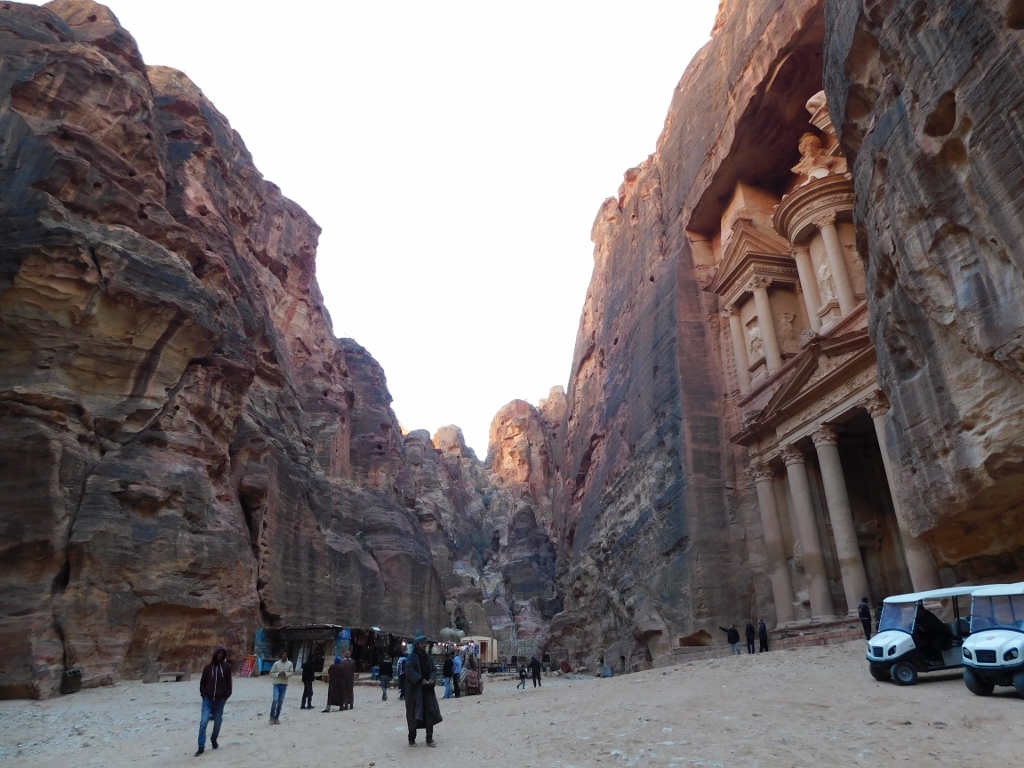 Petra, Wadi al-Jarra
Petra, Wadi al-Jarra
It was also interesting to see the entrance leading into the Siq, but from the direction of the Treasury.
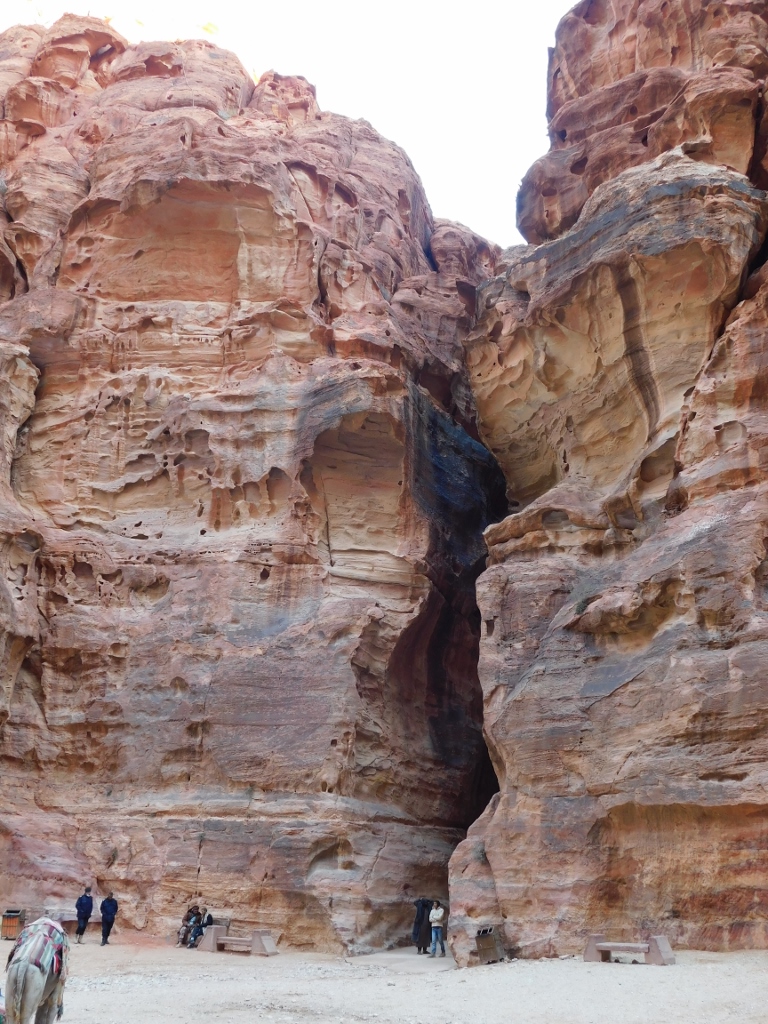 Entrance to the Siq from the direction of Petra
Entrance to the Siq from the direction of Petra
It also needs to be said here that in Wadi al-Jarra, left of the entrance into the Siq, there is another tomb carved in the cliff, but I was overwhelmed by having finally seen the Treasury live that I was not interested at all in some side tombs. The visitors may also climb a trail (with or without a guide) from here in order to have a nice view at the Treasury from up high. I was not interested in this either, because by now I already had a very intensive feeling of heaviness in my body. As I would realise later, this was simply a piled up huge quantity of tiredness that I first carried from home and to which I only added more by daily seriously detailed visits to different sites, while the previous day I also did some intensive hiking. The only thing that carried me here was my enormous wish to visit Petra. The consequences of all of this will be seen only in a couple of days. But, later about it, when the time comes.
For the time being I can say that I moved on through a small gorge called the Outer Siq.
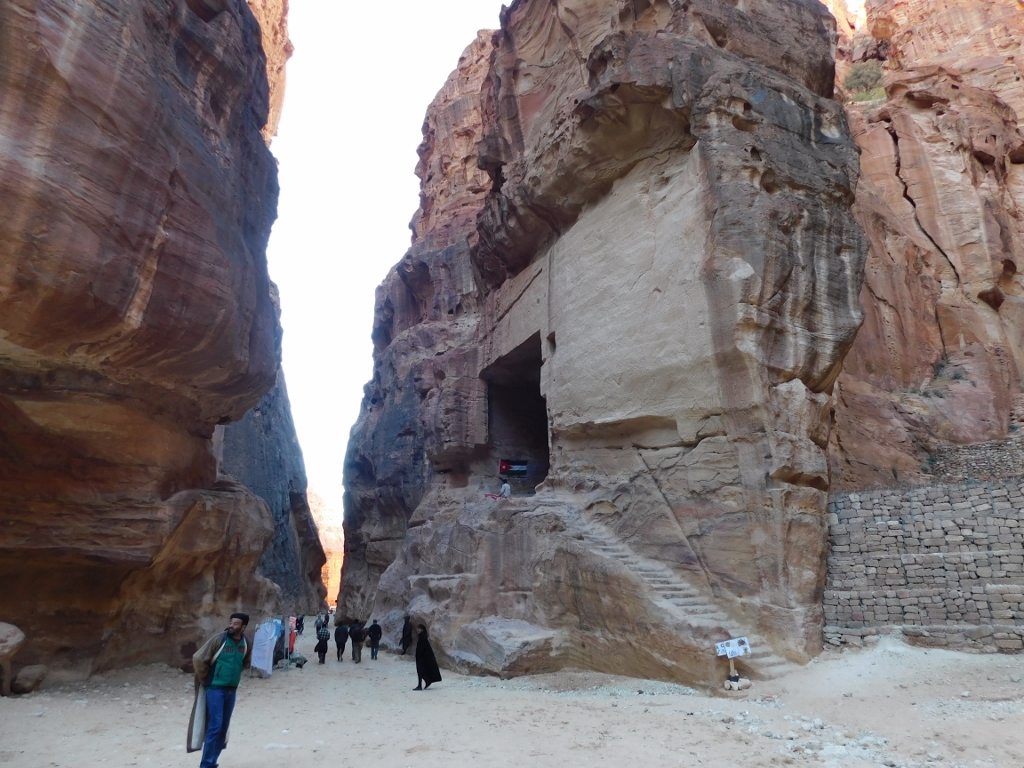 Petra, Outer Siq
Petra, Outer Siq
On the right-hand side of the photo above you can see a staircase leading to the biggest triclinium in Petra. I have already mentioned that this term denotes a dining room used here during local feasts honouring the dead.
In the Outer Siq there are also different tombs, but they are at a different degree of decay caused by the multi-century erosion.
This January afternoon there were hardly any visitors in the Outer Siq and the people who could be seen there were mostly idle local guides or vendors of different souvenirs. I was not interested in any of that, instead focusing my attention on the facades seen at the end in the Street of Facades that were lit by the sunlight reflected against the facades on the opposite side of the street.
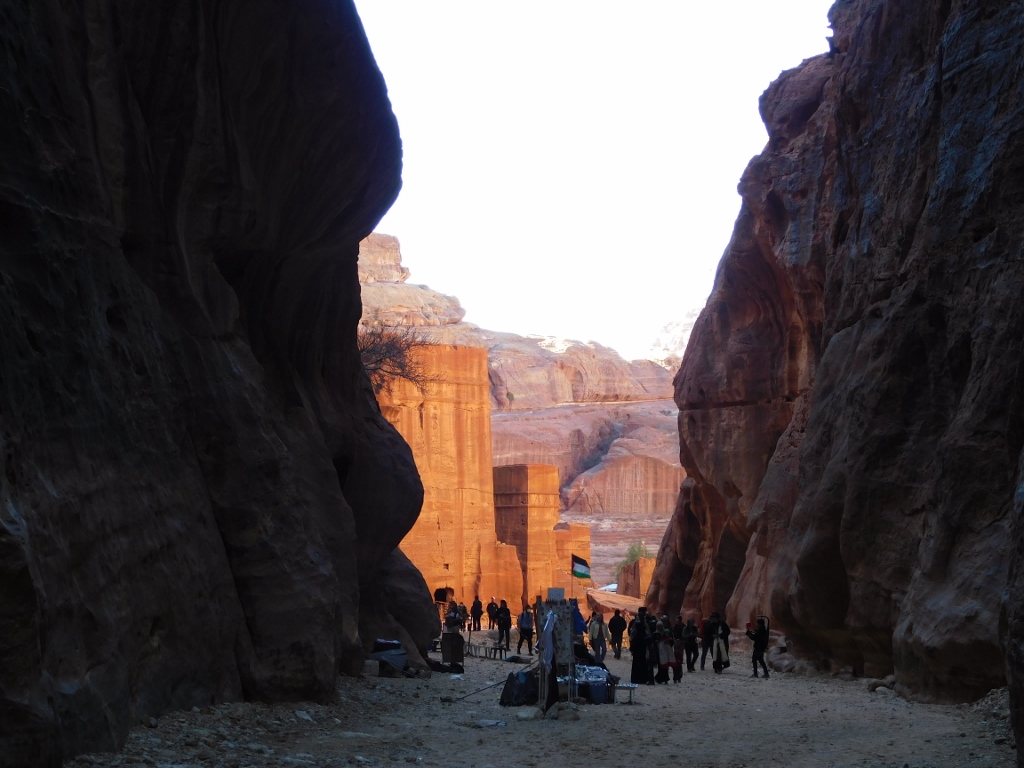 Petra, Outer Siq and sunlit Street of Facades
Petra, Outer Siq and sunlit Street of Facades
Once you leave the relatively narrow Outer Siq, you reach a section of the wide path on the sides of which you can see numerous tomb facades carved in the cliff one next to the other, presumably at the end of the 1st century BCE and until the middle of the 1st century CE. They are located on the southwest side and at this time of the day they were in shade and yet, the sunlight that reflected against the rocks on the northeast side helped illuminate these facades so wonderfully. By the way, on the tomb seen all the way to the left in the photo below, you can see what I wrote about when I talked about the older tombs beneath the Treasury. In the case of these older tombs, only the entrances in the tombs were left (in the photo below the flash flood deposits have almost reached the top of the doorway), while the upper, larger segment of the facade practically disappeared when making the facade of al-Khazneh.
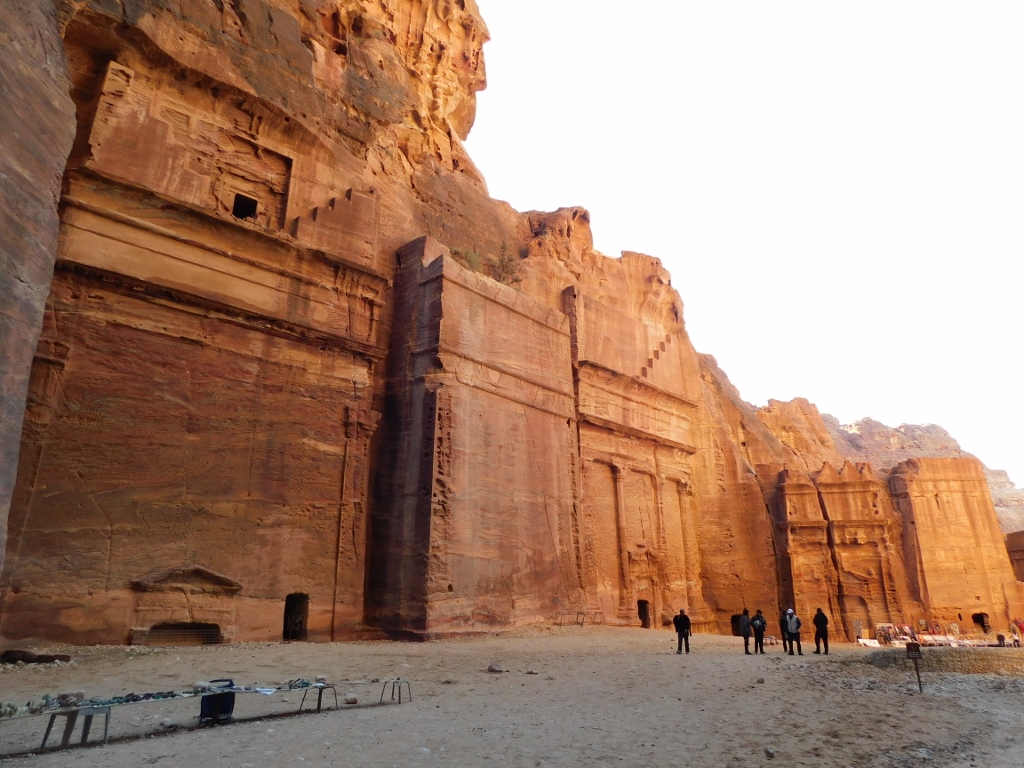 Petra, Street of Facades
Petra, Street of Facades
On the basis of the remains found by archaeologists, it is presumed that these facades were decorated by the stucco technique and painted, but such details are no longer visible owing to the erosion. This does not make them any less impressive.
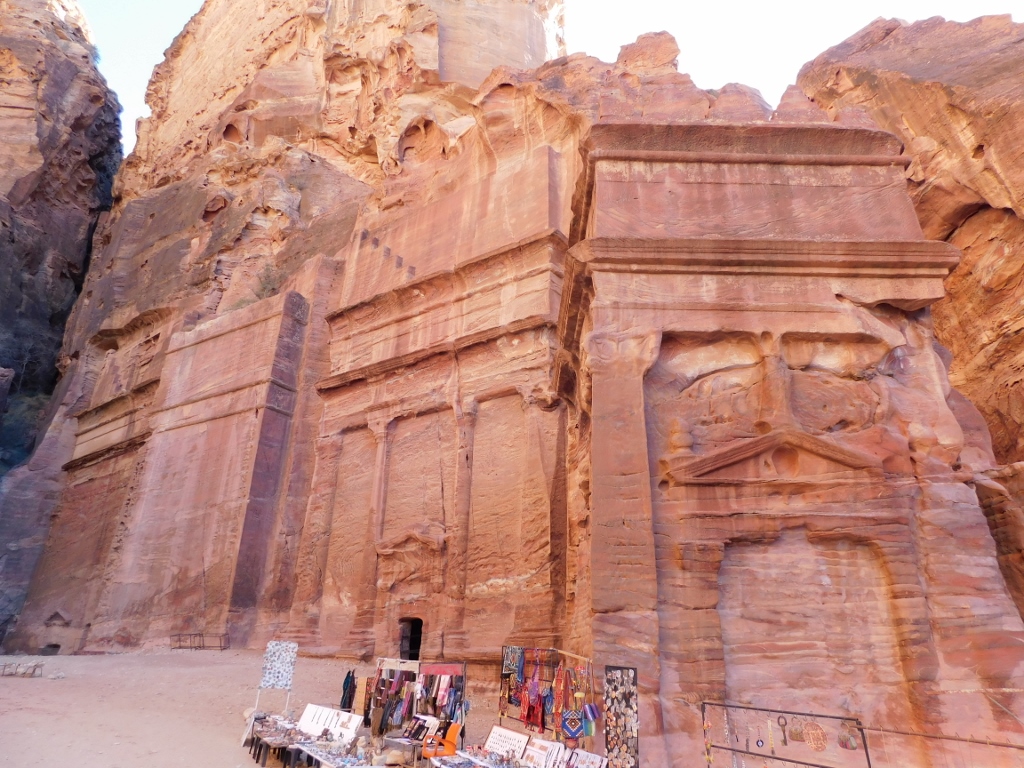 Petra, Street of Facades (view in the direction of the Outer Siq from where I came)
Petra, Street of Facades (view in the direction of the Outer Siq from where I came)
I must admit that before coming here I was essentially acquainted only with the images of the Siq, the Treasury and a monument called the Monastery, which I visited the following day. Of course I read some data that I had in my guidebooks, but this cannot truly prepare the visitor for what can be seen here. To start with, there is the size of the site and then the multitude of different structures that can be seen here. Certainly, not all of them are (equally) important and therefore one usually does not visit them all, but such a large number of structures really took me by surprise. It could be said that most of these structures are basically of the same type – tombs, and this may take away from them, but the sheer number of them is something that absolutely overwhelmed me. To such a degree that I did not know where to look first. That’s why I decided to stick to this main wide path and to walk along it this afternoon to the centre of ancient Petra which is around 1.6 km away from the Treasury.
On the other hand, when I wrote these stories back at home combining them with my photos, I realised I did not have any frontal photo showing that path or the “street” with tomb facades on the flanking cliffs. I only took photos of one side and then of the other. Perhaps that frontal view did not impress me too much, but the fact remains that it cannot be seen in my photos.
Be as it may, on the right-hand side of the Street of Facades it is also possible to see numerous facades some of which have been smoothed out by the multi-century erosion or have been buried under the multi-century gravel debris. In any case, here is a photo of the right-hand side of the Street of Facades where you can see a facade “smoothed out” by erosion, as well as a relatively recently made bed for the flow of the seasonal Wadi Musa stream.
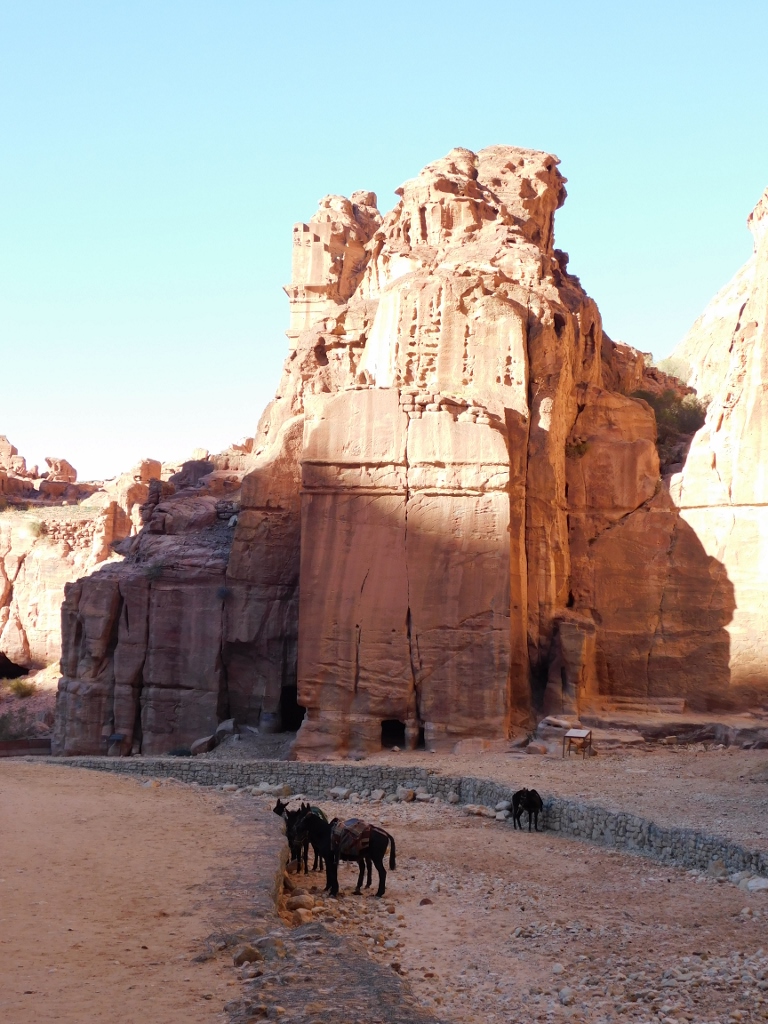 Petra, Street of Facades, right-hand side and the currently dry bed of the Wadi Musa stream
Petra, Street of Facades, right-hand side and the currently dry bed of the Wadi Musa stream
Namely, when it rains a lot here, even today a torrential stream may easily form. As I’ve mentioned before, before the Nabataeans protected the Siq with the dams, there were regular flash floods that forcefully filled the valley in which the centre of Petra was. One should keep in mind that this area is all made of rocks. When it rains there is no soil to absorb the water, there are no tree roots that can hold that water and water-saturated soil. No. All the rainfall simply flows down the rocks and cliffs and rushes towards the lowest point and that is the centre of Petra.